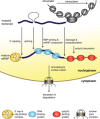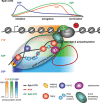Co-transcriptional mRNP formation is coordinated within a molecular mRNP packaging station in S. cerevisiae
- PMID: 25801414
- PMCID: PMC5054900
- DOI: 10.1002/bies.201400220
Co-transcriptional mRNP formation is coordinated within a molecular mRNP packaging station in S. cerevisiae
Abstract
In eukaryotes, the messenger RNA (mRNA), the blueprint of a protein-coding gene, is processed and packaged into a messenger ribonucleoprotein particle (mRNP) by mRNA-binding proteins in the nucleus. The steps of mRNP formation - transcription, processing, packaging, and the orchestrated release of the export-competent mRNP from the site of transcription for nuclear mRNA export - are tightly coupled to ensure a highly efficient and regulated process. The importance of highly accurate nuclear mRNP formation is illustrated by the fact that mutations in components of this pathway lead to cellular inviability or to severe diseases in metazoans. We hypothesize that efficient mRNP formation is realized by a molecular mRNP packaging station, which is built by several recruitment platforms and coordinates the individual steps of mRNP formation.
Keywords: TREX; gene expression; mRNA processing; mRNP formation; molecular mRNP packaging station; nuclear mRNA export; transcription.
© 2015 The Authors. Bioessays published by WILEY Periodicals, Inc.
Figures


Similar articles
-
Formation of export-competent mRNP: escaping nuclear destruction.Curr Opin Cell Biol. 2005 Jun;17(3):287-93. doi: 10.1016/j.ceb.2005.04.009. Curr Opin Cell Biol. 2005. PMID: 15901499 Review.
-
New clues to understand the role of THO and other functionally related factors in mRNP biogenesis.Biochim Biophys Acta. 2012 Jun;1819(6):514-20. doi: 10.1016/j.bbagrm.2011.11.012. Epub 2011 Dec 20. Biochim Biophys Acta. 2012. PMID: 22207203 Review.
-
Early formation of mRNP: license for export or quality control?Mol Cell. 2003 May;11(5):1129-38. doi: 10.1016/s1097-2765(03)00191-6. Mol Cell. 2003. PMID: 12769839 Review.
-
Perturbation of mRNP biogenesis reveals a dynamic landscape of the Rrp6-dependent surveillance machinery trafficking along the yeast genome.RNA Biol. 2019 Jul;16(7):879-889. doi: 10.1080/15476286.2019.1593745. Epub 2019 Apr 21. RNA Biol. 2019. PMID: 31007122 Free PMC article.
-
Nuclear export of mRNA.FEBS Lett. 2001 Jun 8;498(2-3):150-6. doi: 10.1016/s0014-5793(01)02482-6. FEBS Lett. 2001. PMID: 11412847 Review.
Cited by
-
Quick or quality? How mRNA escapes nuclear quality control during stress.RNA Biol. 2017 Dec 2;14(12):1642-1648. doi: 10.1080/15476286.2017.1345835. Epub 2017 Jul 31. RNA Biol. 2017. PMID: 28708448 Free PMC article. Review.
-
Npl3 functions in mRNP assembly by recruitment of mRNP components to the transcription site and their transfer onto the mRNA.Nucleic Acids Res. 2023 Jan 25;51(2):831-851. doi: 10.1093/nar/gkac1206. Nucleic Acids Res. 2023. PMID: 36583366 Free PMC article.
-
Structural insights into the nucleic acid remodeling mechanisms of the yeast THO-Sub2 complex.Elife. 2020 Nov 16;9:e61467. doi: 10.7554/eLife.61467. Elife. 2020. PMID: 33191913 Free PMC article.
-
The yeast Ty1 retrotransposon requires components of the nuclear pore complex for transcription and genomic integration.Nucleic Acids Res. 2018 Apr 20;46(7):3552-3578. doi: 10.1093/nar/gky109. Nucleic Acids Res. 2018. PMID: 29514267 Free PMC article.
-
Nsp14 of SARS-CoV-2 inhibits mRNA processing and nuclear export by targeting the nuclear cap-binding complex.Nucleic Acids Res. 2023 Aug 11;51(14):7602-7618. doi: 10.1093/nar/gkad483. Nucleic Acids Res. 2023. PMID: 37260089 Free PMC article.
References
-
- Rondon AG, Jimeno S, Aguilera A. 2010. The interface between transcription and mRNP export: from THO to THSC/TREX‐2. Biochim Biophys Acta 1799: 533–8. - PubMed
-
- Topisirovic I, Svitkin YV, Sonenberg N, Shatkin AJ. 2011. Cap and cap‐binding proteins in the control of gene expression. Wiley Interdiscip Rev RNA 2: 277–98. - PubMed
Publication types
MeSH terms
Substances
LinkOut - more resources
Full Text Sources
Other Literature Sources
Molecular Biology Databases

